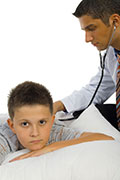- Skip Storing This Everyday Product in the Fridge Door
- Green Tea + B3 Pairing May Boost Brain Health
- Navigating Your Midlife Crisis: Embracing New Possibilities
- City Raccoons Showing Signs of Domestication
- Mapping the Exposome: Science Broadens Focus to Environmental Disease Triggers
- One Week Less on Social Media Linked to Better Mental Health
- Your Brain Changes in Stages as You Age, Study Finds
- Some Suicide Victims Show No Typical Warning Signs, Study Finds
- ByHeart Formula Faces Lawsuits After Babies Sickened With Botulism
- Switch to Vegan Diet Could Cut Your Greenhouse Gas Emissions in Half
Heart Docs Don’t Recommend Routine ECGs for Young Athletes


U.S. heart experts recommend doctors use a 14-point checklist rather than an electrocardiogram (ECG) when evaluating young people for underlying heart disease that could result in sudden cardiac arrest.
The American Heart Association and the American College of Cardiology said in a joint statement that a more detailed personal and family medical history along with a physical examination can help identify young people with genetic or congenital (existing from birth) risks for sudden cardiac death.
The statement, published Sept. 15 in Circulation and the Journal of the American College of Cardiology, also recommended wider distribution of automatic external defibrillators in public places, such as sports arenas and schools. These devices can save lives in the event of cardiac arrest, the experts said.
Highly publicized, rare cases of healthy young athletes dying while playing sports have led to requests in some countries for mandatory screening of all athletes with an ECG, according to a news release from the two heart organizations. But the cardiologists said this costly step isn’t warranted.
Sudden cardiac arrest is no more common among young athletes than other teens and young adults, the doctors said. “Using 12-lead electrocardiograms to detect underlying congenital or genetic cardiovascular heart disease as a screening tool in healthy people 12-25 years old without positive findings on the history and physical examination has not been shown to save lives,” the heart experts said.
“The media coverage of sudden cardiac arrests in athletes may have created the exaggerated impression that these tragic events are far more common than they actually are, or that they are limited to athletes,” Dr. Barry Maron, chair of the writing panel for the statement and director of the Hypertrophic Cardiomyopathy Center at the Minneapolis Heart Institute Foundation, said in the release.
“Those who do not sign up for sports are just as likely to have the genetic heart diseases that raise the risk for sudden death. Since there are by far more nonathletes — only about 1 percent of college students and 30 percent of high school students participate in competitive sports — there are more deaths in nonathletes participating in recreational sports and normal daily activities,” Maron said.
According to the heart experts, the questions doctors should ask to evaluate heart risks include whether or not a patient has experienced unexplained fainting, chest pain, or unusual shortness of breath or fatigue during exercise.
Young people should also be questioned about their family history, including whether or not any close relatives died at a young age from heart disease or a heart condition involving the heart muscle or heart rhythm. Also, have they ever been restricted from participation in sports or had heart tests ordered by their doctor?
If any of these factors are positive, additional testing may be needed to identify heart defects.
Although an ECG can help detect congenital heart disease that can lead to sudden cardiac death, this test should not be used unless a doctor has determined a young person is at increased risk for a heart abnormality, the experts advised.
Pediatric ECGs can be particularly difficult to interpret since the results change with growth and development, the experts cautioned.
Also, ECG screening for congenital heart defects would be costly, they said. To screen young athletes alone would initially cost at least $2 billion each year.
More information
The U.S. Centers for Disease Control and Prevention provides more information on congenital heart defects.
Source: HealthDay
Copyright © 2025 HealthDay. All rights reserved.










